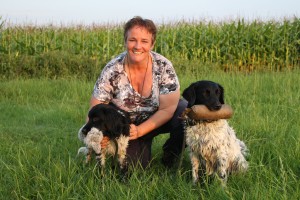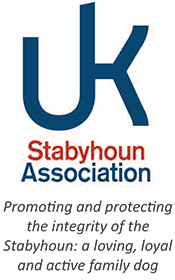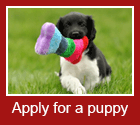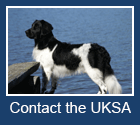By Brigitte Elsman

Brigitte Elsman with Rivan and her mother Imre
When Floran was just a puppy, I went to puppy training with a lady called Willeke. It was she who told me about hunting training and the demonstration she gave with her dog left a big impression on me: I wanted to do that too!
Together we attended hunting training of the Royal Dutch Hunting Society (KNJV). I was just a beginner and Floran had a hard time at the training sessions with difficulties retrieving and swimming. Really, none of us enjoyed it. The trainers were harsh and used force to teach the dogs the required skills. ‘If this is how I need to teach my dog to work then I quit’ I told Willeke.
We didn’t quit but instead found a new trainer and Floran became a happy dog again. By being consistent, clear and using a positive approach, I taught Floran within a few weeks the purpose of hunting. She was retrieving and swimming without any difficulty after I went into the water with her just a few times. I felt such regret at having taken her to the previous classes, seeing what a great dog she really could be.
Alongside Willeke and her Münsterlander we now trained twice a week at least and made great progress – changing exercise regime and location all the time to make it fun and teach them to work on a variety of terrains. The biggest challenge was getting Floran to enjoy venison but after a while, she finally did.
We achieved our first KNJV C-certificates with high scores, but failed the water exercises in our first year. Eventually, after a lot more training, we achieved our first B-certificate the year after and subsequent tests were almost a habit. Despite participating in Multiple Retrieving Training and A-certificate training, Floran and I never achieved an A-certificate, although we almost had it.
I attended numerous workshops and training days to better understand my dog. I learned that, although Floran’s strict training regime had produced a very compliant dog, she didn’t enjoy herself – something I was never able to change later on. As a result, she never developed the initiative and perseverance of a good hunting dog.
“I attended numerous workshops to better understand my dog”
With her daughter, Imre, my approach was entirely different. I understood the psyche of the Stabyhoun and was determined not to make the same mistakes again. From the age of just 8 weeks, Imre and I began positive hunting training alongside ‘normal’ puppy classes. She was introduced to game at a very early age and happily carried around a duck wing or rabbit skin. I taught her to retrieve by using clicker training and, within a few days, she understood what I wanted from her and she retrieved perfectly. I introduced her to water at a young age in a fun way and she still loves to swim. Unlike her mother, Floran, Imre loves to work and carries her tail high in the air. She is also stubborn; a typical Stabyhoun that works with great enthusiasm but also creates her own pleasures. The compliance of her mother is far lost in the case of Imre but she is a better worker albeit without having achieved as high a score in her B-certificates as Floran. She still has time though.
Now, with Imre’s daughter Rivan, I am doing it completely different again. I want my dog to be enthusiastic while retrieving, but also compliant. Rivan was introduced to game when she was just weeks old, and always retrieved independently and happily which I praised. I train with her in a small group with other dogs where the focus is on making sure the dogs love to retrieve. Besides that, we also go to ‘normal’ puppy training. Steadiness exercises are reserved for during dinner or before exiting the car; she has to learn to wait for permission. I am consistent but enthusiastic and Rivan earns a lot of compliments. Key to our training these days, however, is that the exercises are devised so that the dogs always succeed. Rivan’s character is more like her grandmother Floran and this time I know how to nurture it.
So there you have it; three different dogs, three characters, three different methods of training. The first is by far the least suitable for this breed, the second a lot more appropriate for dogs that need to be controlled, and the third is up to now the most successful. Be positive, encouraging and always set your dog up to succeed.








